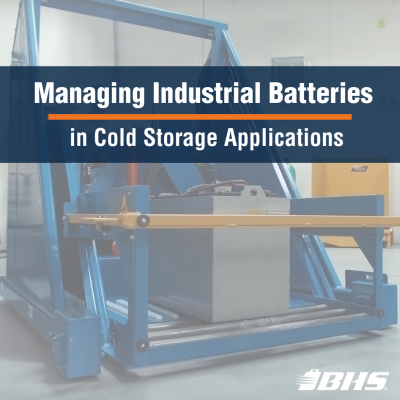We use cookies to make your experience better. To comply with the new e-Privacy directive, we need to ask for your consent to set the cookies. Learn more.
Managing Industrial Batteries in Cold Storage Applications

While electric forklifts are ideal for cold storage facilities, low temperatures aren’t great for battery performance. The battery that provides a full eight hours of power in ambient temperatures might give out after just half that time in below-zero temperatures. The additional charge cycles wear on batteries and cut down on overall performance life.
Users can address and minimize these issues by tailoring battery-management programs to their cold-storage realities. Here are a few important things to keep in mind when handling industrial batteries in cold-storage warehouses:
- Choose the right batteries. Cold weather diminishes a lead-acid battery’s capacity by thickening the electrolyte, slowing down the chemical reaction between sulfuric acid and lead that creates power. Unfortunately, there’s not much you can do about that; it’s chemistry. The battery you buy does make a difference, though. Some industrial batteries use special electrolyte mixtures designed to retain fluidity in freezing temperatures. Some stuff more, thinner lead plates into the case. These are the technologies you should look for when purchasing forklift batteries for cold-temperature use.
- Run batteries to their full discharge capacity before recharging them. It can be tempting to drop a battery off at the charging station when your shift’s over, even if it still has half a charge left. This is called “short-cycling” the batteries, and it’s costly in any application, but especially in cold storage. Short-cycling causes electrolyte to stratify, leading to capacity loss. With an already reduced capacity due to the cold temperatures, this can quickly waste a battery’s value.
- Use battery fleet management tools. By now, it should be evident that proper discharging and charging intervals are crucial to battery performance in cold environments. Battery management systems like Fleet Tracker give operators the data they need to ensure every unit gets ideal charging and cooling cycles, as well as all necessary maintenance.
- Configure Battery Extractors for cold-storage use. If you operate forklifts that move from ambient to cold temperatures and back again, you’re always fighting the problem of condensation. Even battery handling equipment itself is vulnerable to condensed moisture — unless it’s built for the job, that is. Cold storage applications may need portable extraction equipment, like the Mobile Battery Extractor (MBE). The MBE, outfitted for vacuum extraction, is ideal for handling batteries anywhere in a facility, including where condensation may be present.
No matter how well you maintain your battery fleet, understand that cold-storage operations may need more units on hand than ambient-temperature warehouses. Data from Fleet Tracker systems can help users right-size their battery collections, giving forklift operators all the power they need without wasting time, space, and money on unnecessary battery stock.
In other words, industrial batteries in cold storage applications face a lot of the same challenges as any other warehouse. By choosing the right batteries in the first place, then relying on management systems to help maintain the collection, operators in cold storage warehouses can enjoy the benefits of electric forklifts without worrying about batteries.
References:
Bond, Josh. “Lift Truck Tips: Batteries take more heat in cold storage.” MMH. Peerless Media LLC, 1 Nov. 2014. Web. 29 Jun. 2019.
Bond, Josh. “Lift Truck Tips: Don’t get left out in the cold.” MMH. Peerless Media LLC, 9 Nov. 2018. Web. 29. Jun. 2019.
Vanasse, Harold. “Battery, forklift maintenance tips to achieve sustainable cold storage operations.” RefrigeratedFrozenFood. BNP Media, 16 Apr. 2019. Web. 29 Jun. 2019.
